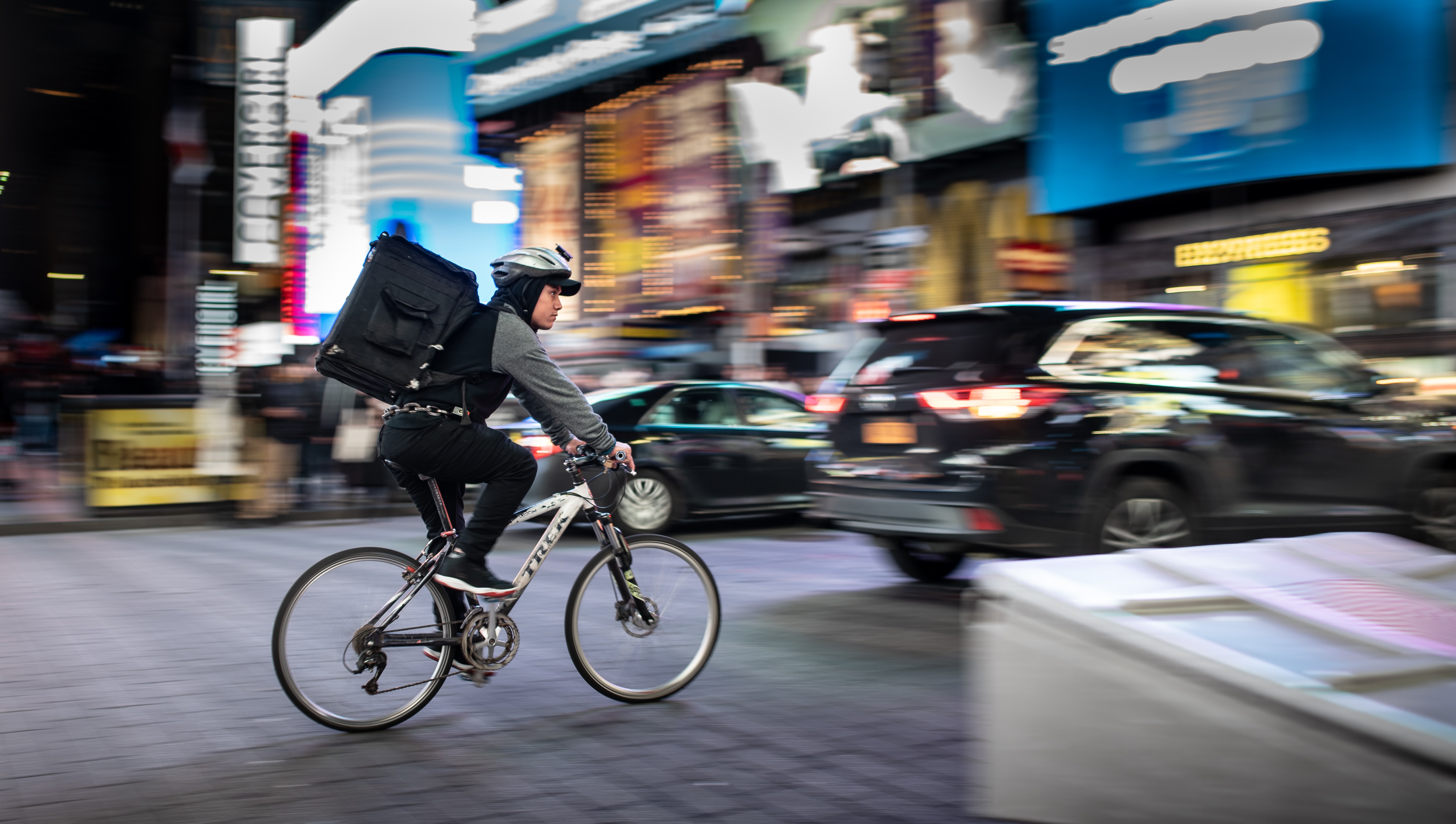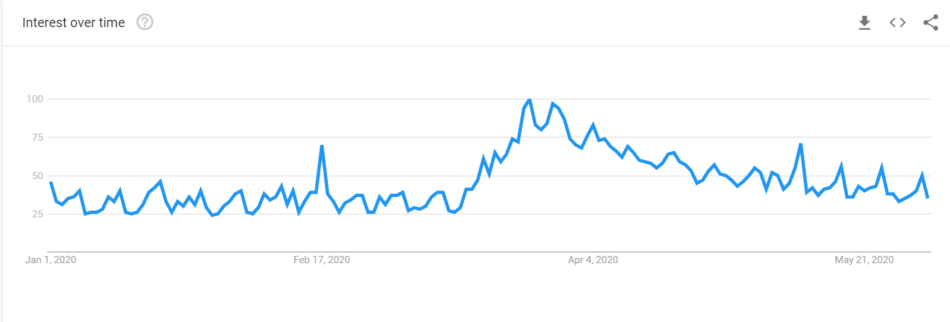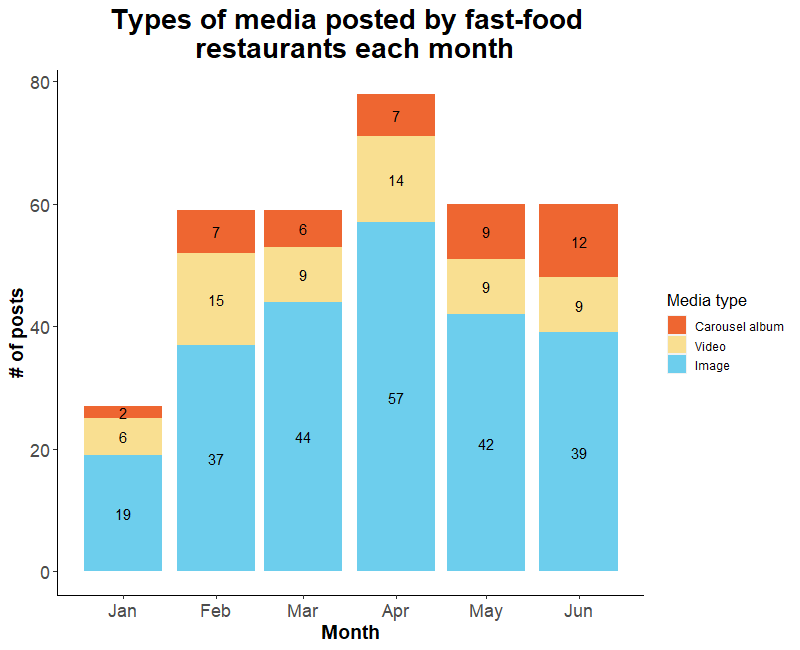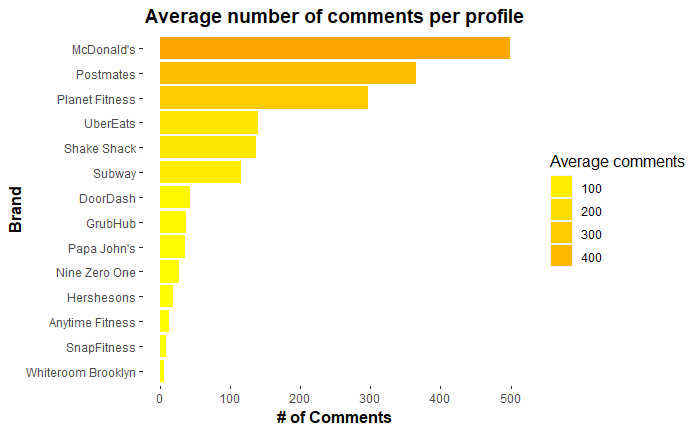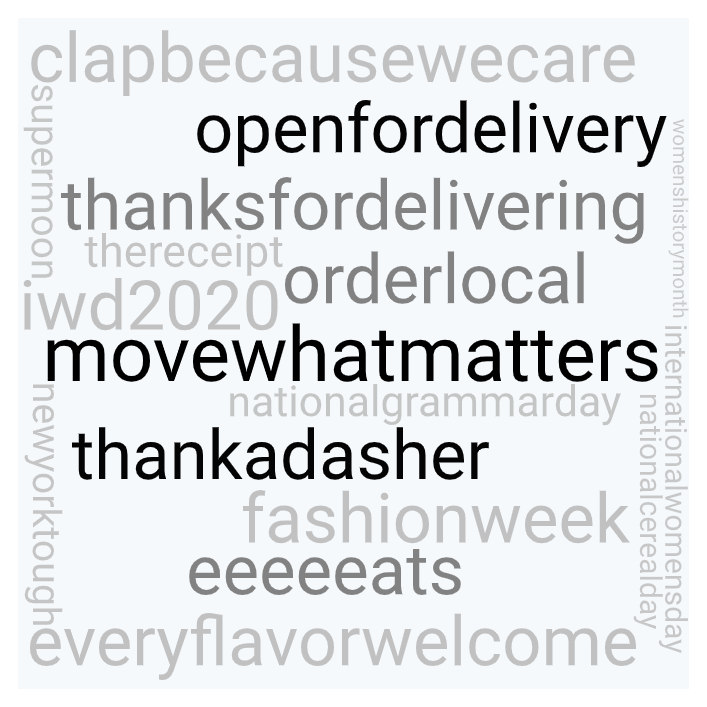Last time you were here, we analyzed Instagram API data to see how the beauty salon and fitness center industries adapted to the lockdown. We suspected that they would be impacted by the COVID-19 lockdown, and we were right. Now, we are going to check how fast-food chains and delivery apps were affected by the same Coronavirus lockdown restrictions.
Analyzing Instagram data isn’t a new thing at Sotrender. But since we know that a large portion of our crowd consists of marketers, social media managers, and those interested in social data, we thought it might be interesting for you. Our goal was to analyze the ways that customers and followers of both fast-food chains and delivery apps on a highly interactive social media platform.
Anyway, here’s what we found. 🙂
Why analyze this data?
We previously mentioned that one of our Audience Interest analyses showed that users’ interests were changing on Facebook. Since more people were spending time online and had to find ways to adjust their habits during the lockdown, some Facebook Pages started to gain popularity. Pages of airlines or resorts didn’t have the same experience, though.
For example, we can see that online shopping started to become more relevant in 2020, whereas aviation dropped a few points (for pretty clear reasons). Since online shopping started gaining traction on Facebook, it would make sense that food delivery apps would get more attention on other social media channels.

Tip: The division between some of these categories might not seem so clear, so we’ll break it down. Categories are based on whether or not you’ve interacted with content published by Facebook Pages that were categorized in that way. Basically, if you liked a post, an ad, or a Page by a social media company, you’re probably going to be placed in the “Online” category.
On that note, Google Trends also showed that some keywords blew up in a very short period of time. For example, the keywords “food delivery” became particularly popular worldwide when governments started to take precautionary measures.
When we checked how restaurants were doing, however, we found the opposite trend emerging. Since things were looking grim for the dining industry, we expected the interactions between those fast-food restaurants and their customers to differ online.
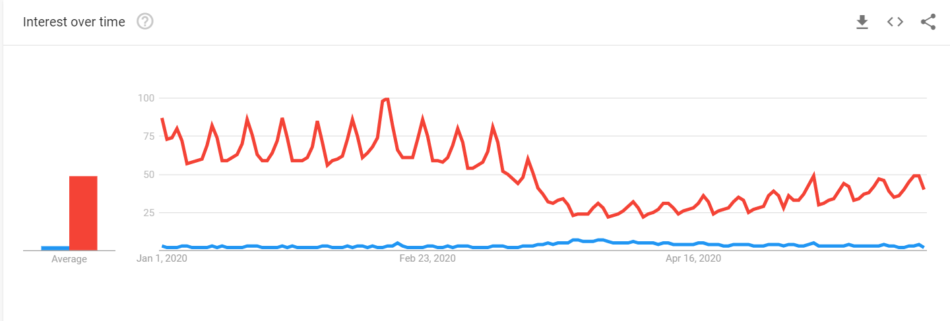
Note: the red line represents the keyword restaurant, while the blue line in comparison shows food delivery.
This makes sense since restaurants keep customers in close proximity to each other, which could easily further contagion. Therefore, we wondered how did one industry that seemed to become more relevant during the lockdown change their strategy, and how did it compare to one that faced a huge challenge.
Based on this initial research, we decided to take a deeper dive into the social media profiles in these industries to get some answers.
What did we want to answer?
To do that, we needed to answer these questions:
- Did the industries differ when it came to types of posts they published?
- What hashtags emerged during the two-month lockdown period?
We just need to remind you that we gathered this data via the Instagram API. The results we report are based and dependent on the data that the API allowed us to download. We organized the data according to before the lockdown (January and February), during the lockdown (March and April), and post-lockdown or during a time when governments were easing restrictions (May and June).
You can read more about our findings in the sections below. 🙂
Fast-food restaurants and chains
Based on reports by Statista, the fast-food industry was worth more than 250 billion USD back in 2018. What’s more, there are more than 230,000 fast-food locations around the US. Fast-food restaurants maintained their position as an important industry in the current economy. We wanted to see how they would change their online behavior to interact with their followers since they could no longer do so in person.
We included the following fast-food restaurants in this category:
- Papa John’s (US)
- Subway (US)
- Shake Shack (US)
- McDonald’s (UK)
What kind of posts did fast-food restaurants upload?
As always, image posts dominated the type of media published on Instagram. That’s likely because it takes fairly little time to organize and edit the whole post compared to video posts. You don’t even need many resources to create high-quality image posts, there are many tools for creating and editing images and GIFs available.
Regarding pure numbers of posts, there were especially more posts published in April than any other month. However, the distribution of the posts seemed to be around the same each time. There were slightly more carousel albums in May and June, though.
None of the videos that were posted by fast-food restaurants showed how their food was made. Instead, they posted short ad-type videos promoting events, sales, or new items on their menus. Subway did include a carousel album that can be useful to their followers. The post explained the ways that their locations were keeping their locations and food production sanitary.
To sum up, all of the fast-food restaurants posted more images than any other format on Instagram. There was an increase in the number of image and video posts in April, though it appeared to go back to normal right after. They had a very clear pattern when it came to the number of posts and how those posts would be divided into media types.
How many comments did fast-food restaurants get over time?
The reason why we want to compare the number of comments each chain received is to determine if there is a certain type of post or campaign that appeals to their target audience. As the number of comments increases, so does the chance that your target audience will stay interested in and interact with your brand. Now we’ll take a closer look at how the comments fluctuated over time.
Firstly, it’s worth pointing out that the number of posts per month doesn’t necessarily have to translate to the number of comments. For example, Shake Shack and Subway didn’t post at the same rate, but they had the same number of comments on average.
You’ll notice that McDonald’s UK had three moments when the number of comments peaked. It started in late March, and continued up until the end of June. Shake Shack, however, only had one peak in closer to the time when restrictions were being lifted.
Overall, we get the impression that the posting strategy didn’t change their followers reactions that much for Subway. Still, McDonald’s and ShakeShack peaked during the lockdown period, with Papa John’s only getting an increase after it. We’ll show you some of their posts in one of the next sections. 🙂
What hashtags did the fast-food restaurants use?
When your plan is to increase reach, you generally want to use relevant hashtags on Instagram. A relevant hashtag could be related to the topic of the post (a collaboration between brands or an event), brand-specific or product-specific, or their overall industry. Hashtags also make it easier for both the company and the followers to communicate with each other. For example, if a brand is hosting a competition and they’re relying on user-generated content, then the only way for them to find their followers’ posts is by searching for that specific hashtag.
In the end, the only hashtags that appeared and are related to the pandemic were #thegreatamericantakeout, #couchella, and #deliveringthanks. So it looks like the only hashtag that food delivery apps and fast food chains have in common was #deliveringthanks. Other noteworthy mentions include how Shake Shack just uses their own brand name as a hashtag regularly and how Papa John’s was promoting their own products by pairing up with WWE for wrestlemania.
However, you’ll notice that many of these hashtags are related to Papa John’s – including #pjxwwe, #papaprofiles, and #spicygarlicsauce. It seems that Papa John’s is using a lot of brand-specific hashtags.
Examples of posts
Finally, we’ll be showing you the content of the posts uploaded by the companies in this industry. Unlike the beauty salons and fitness centers, these fast-food chains didn’t provide at-home guides or courses, but instead focused on discount codes, presenting their employees in a good light, or PR.
Shake Shack took the opportunity to parody Coachella by posting their version of Couchella. Since the event was cancelled this year, they marketed the alternative of staying at home, ordering from their menu from Postmates. Instead of creating a lineup of artists, they created their lineup using the different items on their menu.
However, it’s worth noting that some of their PR activities backfired and were heavily criticized in their comments sections and elsewhere, such as Shake Shack for returning their PPP loan (meant for small businesses, and not corporations).
Meanwhile, here’s what it looked like when Papa John’s included the lockdown related hashtag #deliveringthanks. This was their way of trying to say that they are grateful for their employees and to encourage their customers to do the same.
Conclusion
Restaurants needed to find ways to keep up with their audience so their audience doesn’t forget about them. The posts where they shared coupon codes, hygiene practices and suggestions, and thanking service workers were well received. The clearer PR stunts – not so much. Images were the most commonly posted media type, and new hashtags related to Coronavirus and thanking industry workers became more common during the lockdown period.
Food delivery apps
If you own a phone with iOS or Android, you’ve probably been recommended a food delivery app on your phone’s store. Research by Zion and Zion that included almost 3000 consumers in the U.S. found that around 41% of them used a food delivery app or service at least once. Even if the majority of those surveyed didn’t use it once, 41% is still a large portion of the sample.
Although food delivery apps have been around for a while, they became extremely popular and even necessary to keep people safe during the outbreak. Delivery apps made it possible for their users to order large quantities of food from grocery stores and restaurants while avoiding crowded places. The added bonus and convenience of paying by card ahead of time was also safer for everyone involved.
We selected the delivery apps based on their popularity, and according to Zion and Zion, the top four most downloaded apps were:
- GrubHub
- UberEats
- DoorDash
- Postmates
We analyzed these apps in the same way as the restaurants, and we’ll go over how they performed in comparison to the fast-food chains.
What kind of posts did food delivery apps upload?
Interestingly, the two industries differed in the types of content they posted. Food delivery apps posted image posts between slightly above 50% up to 75% over the year. The fast-food industry had generally kept the same amount of videos throughout the months, though this is visibly not the case for food delivery apps.
It looks like the food delivery apps had more diversity in their content strategy. There were many more carousel albums posted by food delivery apps on their Instagram profiles than by fast-food restaurants. We discuss some of the different carousel albums they’ve posted further down the article.
Videos became more popular in April and May, though they were generally rarely posted before the outbreak and after restrictions were lifted in June.
How many comments did food delivery apps get over time?
Why do we bother looking into how many comments are under a post? The simple answer is that it shows your audience engagement on Instagram. An engaged audience is more invested enough in your brand to actively participate in conversations on your profile. This interest indicates that they’re more likely to actually remain a customer (as long as the comments aren’t negative).
We know that the Instagram algorithm isn’t more likely to favor your post if you have hundreds of thousands of likes but almost nonexistent comments. Actually, it seems to favor posts with better engagement or that are more relevant to the user. Some of the ways that this engagement is measured is via the number of comments, Story replies, or saved posts. Since you need access to Insights to access the latter two, we analyzed the number of comments. 😉
Since this is the last industry we analyzed, we’re going to show you something we didn’t include before. We calculated the average number of comments each profile got over time.
On average, McDonald’s and Postmates were doing extremely well in the average number of comments on their profiles (almost 500 and 400 comments respectively). UberEats, Shake Shack, and Subway also had between 100 and 200 comments on average. Again, it’s important to remember that the number of followers that follow an account could influence the number of comments they get. So we’d like to remind you that it’s good to regularly check up on your Activity Index to make sure that your engagement isn’t declining. 🙂
Now we’ll check how it changed over time.
Postmates had the greatest surge in comments around March and April, while UberEats had gained more comments only around June. It’s an interesting contrast, especially given that GrubHub and DoorDash had the same amount of comments throughout the months. It looks like only two really stood out.
What hashtags did the food delivery apps use?
Since food delivery apps and fast-food chains both rely on delivery drivers, there was a bit of an overlap between the most used hashtags. Out of all of the industries we’ve looked at, it makes the most sense for food delivery apps to use COVID-19 related hashtags. Their drivers are the ones that are putting themselves at risk, after all.
First of all, it should be clear that many of these hashtags appear at similar frequencies. This might suggest that the food delivery apps regularly use hashtags in their posts. The hashtags that stand out are #movewhatmatters, #thankadasher, #everyflavorwelcome, and #openfordelivery. It seems that the most used ones are related to the pandemic.
When we took a closer look at UberEats, we noticed that they post close to one hashtag per post. DoorDash, however, used the hashtags such as #thankadasher and #thanksfordelivering while sharing Dashers’ and customers’ stories about their experiences during this time. We should note that there were only 49 posts using the #thankadasher hashtag, while the more inclusive #thanksfordelivering hashtag had more than 1,600 posts.
Overall, these hashtags are meant to be encouraging to their drivers and show their customers that it’s important to value the services they provide. They shared posts to encourage their followers to stay inside and allow for essential workers, restaurant workers, and delivery drivers to do their jobs. Uber Eats generally used the hashtag #movewhatmatters to get that point across.
Examples of posts
Now we’re going to break down the content of the posts that each profile was posting. Like the fitness center profiles in our previous post, DoorDash uploaded posts where they featured individual workers, and they used the #thankadasher and #thanksfordelivering hashtags.
One of the things that users appreciated was the new delivery option – contactless drop-off. This allowed users to have the delivery driver leave the order at the door, knock, and keep a physical distance between the customer and the driver.
However, it’s important to notice that a large portion of the comments consist of complaints that the food delivery apps’ CS teams didn’t address or that their company didn’t handle smoothly. Unfortunately, most of the posts didn’t have a company rep, CS specialist, or social media manager answer the complaints, so the comments don’t represent the brands well. We generally recommend answering your customers, especially when they’re upset. It ends up benefiting everyone in the end, after all.
Conclusion
The food delivery apps that we analyzed got more attention during the lockdown than usual. Their content strategy was somewhat different from the restaurants we analyzed. They tried to show their customers how they were going to keep their delivery drivers safe and how they’re financially aiding their restaurant partners and healthcare professionals. They used more carousel albums in their strategy, and they used many brand-specific and product-specific hashtags to promote their company’s goods/services.
The takeaways
Fast-food restaurants and food delivery companies were impacted by the lockdown in rather different ways. While fast-food restaurants were trying to find a way to maintain production, food delivery apps tended to do better. Although these industries wanted to maintain relevance for the most part, they don’t interact with their customers very much. Despite the high number of comments under some of their posts, many of these were negative.
Hopefully these results gave you some insight into how fast-food chains and food delivery apps reacted to the lockdown. Sotrender is invested in learning more about the market and industries by analyzing social media data, so we’ll continue to go analyze other profiles and industries.
If you have any questions or suggestions, let us know. 🙂 And if you’re interested in some type of report or analysis, you can leave a comment or message us via email.
